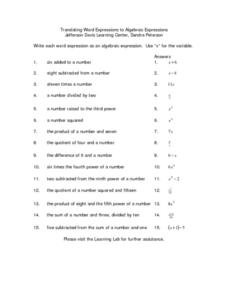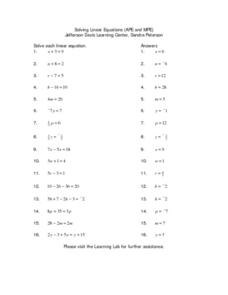Curated OER
The 3 R's of Common Denominators (Language)
Pupils solve various word problems that deal with common denominators, and write the mathematical explanations they used to obtain the solutions.
Curated OER
Spring Potted Plants
Pupils identify and interpret plant growth as well as gain graphing skills and other important knowledge related to potting plants. They take a regular milk jug and cut off the top, leaving the handle and the rest intact. Then, students...
Curated OER
Translating Word Expressions to Algebraic Expressions
In this translating worksheet, students read a word sentence, and then translate it to an algebraic equation. Fifteen problems are provided on this one-page worksheet. Answers are provided on the right-side of the page.
Curated OER
Solving Linear Equations (APE and MPE)
In this linear equation worksheet, pupils use their algebra rules to solve linear equations. This one-page worksheet contains 16 problems, with answers.
Curated OER
Translating Sentences to Equations
In this translating worksheet, students translate word phrases to algebraic equations and then solve the equation. This one-page worksheet contains ten problems. Answers are provided on the page.
Curated OER
Solving Systems of Linear Equations: Elimination Method
In this linear equation worksheet, students solve systems of equations by using the elimination method. This one-page worksheet contains eight problems, with answers.
Curated OER
Logic Plus Math Equals Critical Thinking
Logic problems can be an integral part of the school day.
Curated OER
Reading, Writing, And Math in Daily Living
Students, in groups, make chocolate chip cookies following a recipe.
Curated OER
What You See Is What You Get
Students practice visualization as a strategy for reading and comprehending math word problems.
Baylor College
Food for Kids
Immediately capture the attention of your class with the smell of freshly popped popcorn in the sixth activity of this series on the needs of living things. Young scientists first use their senses to make and record observations of...
Baylor College
What's That Food?
Get things cooking with the first lesson in this series on the science of food. Working in small groups, young scientists make and record observations about different mystery foods. These descriptions are then shared with the class and...
Baylor College
Plant or Animal?
Teach your class about the necessities of life using the book Tillena Lou's Day in the Sun. After a teacher-read-aloud, students make puppets depicting different plants and animals from the story and illustrating the habitat in which...
Baylor College
Need or Want?
Even as adults it can be hard to distinguish needs from wants. Using pictures of common, everyday items, children make a pocket chart separating the objects they need from those that they want. Discuss their choices, explaining that...
Baylor College
Needs of Living Things: Post-Assessment
Assess your class's knowledge of the needs of living things with the final lesson in a series. Given a large piece of paper and coloring utensils, young scientists draw a picture of themselves and a plant or animal of their choosing,...
Baylor College
A Place to Be
Home sweet home. Humans, birds, beavers, ants, we all need a place place to rest and keep us safe. In the ninth lesson of this series, the importance of shelter is discussed as the teacher reads aloud the book Tillena Lou's Day in the...
Baylor College
Pre-Assessment: Earth's Energy Sources
A ten-question, multiple-choice quiz assesses what your elementary earth scientists know about the atmosphere both before and after a unique unit on global atmospheric change. Make sure to check out the activities and lesson plans...
Curated OER
Book Report Task Cards
With 52 task cards, learners will not run out of things to do with a book they are reading independently or with the class. Tasks include making a poster on a specific topic, writing a summary, drafting a sequel, creating a windsock,...
Scholastic
Test-Taking Strategies for Three Subject Areas
Sometimes a test page loaded with text can make a student's face go blank. Help them decipher what a text question is asking with a series of tips focused on reading comprehension, vocabulary, and language arts mechanics.
Facebook
Social Media and Sharing
Whether it's cute cat videos or pictures from an epic vacation, scholars love to check out what's happening on social media! But, how much sharing is too much? A lesson from a vast digital citizenship series poses some serious points to...
NOAA
Tracking a Drifter
Be shore to use this drifter resource. The third installment of a five-part series has learners using the NOAA's Adopt-a-Drifter website to track to movement of a drifter (buoy) in the ocean. Graphing the collected data on a map allows...
University of Colorado
Modeling Sizes of Planets
The density of the huge planet of Saturn is 0.7 g/cm3, which means it could float in water! In the second part of 22, science pupils explore the size and order of the planets. They then calculate weight and/or gravity and density of...
Teach Engineering
The Great Gravity Escape
Groups simulate an orbit using a piece of string and a water balloon. Individuals spin in a circular path and calculate the balloon's velocity when the clothes pin can no longer hold onto the balloon.
Polar Trec
Nature's Density Column
Nature provides density columns in the polar regions that provides food for many animals. Young scientists build their own density columns with water in order to answer analysis questions. Through a slideshow presentation, scholars...
Curated OER
Triangles, Triangles, Triangles
Students view several different types of triangles. They discuss attributes of a triangle with a partner. Students use a straw cut into pieces to create a triangle. They complete a Triangle Hunt worksheet (teacher created). Students...

























